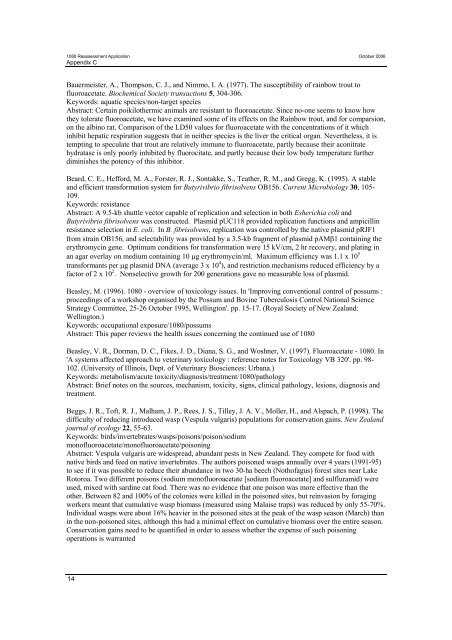Source: Landcare Research (1964). Control of poisons. Royal ...
Source: Landcare Research (1964). Control of poisons. Royal ...
Source: Landcare Research (1964). Control of poisons. Royal ...
Create successful ePaper yourself
Turn your PDF publications into a flip-book with our unique Google optimized e-Paper software.
1080 Reassessment Application October 2006<br />
Appendix C<br />
Bauermeister, A., Thompson, C. J., and Nimmo, I. A. (1977). The susceptibility <strong>of</strong> rainbow trout to<br />
fluoroacetate. Biochemical Society transactions 5, 304-306.<br />
Keywords: aquatic species/non-target species<br />
Abstract: Certain poikilothermic animals are resistant to fluoroacetate. Since no-one seems to know how<br />
they tolerate fluoroacetate, we have examined some <strong>of</strong> its effects on the Rainbow trout, and for comparsion,<br />
on the albino rat. Comparison <strong>of</strong> the LD50 values for fluoroacetate with the concentrations <strong>of</strong> it which<br />
inhibit hepatic respiration suggests that in neither species is the liver the critical organ. Nevertheless, it is<br />
tempting to speculate that trout are relatively immune to fluoroacetate, partly because their aconitrate<br />
hydratase is only poorly inhibited by fluorocitate, and partly because their low body temperature further<br />
diminishes the potency <strong>of</strong> this inhibitor.<br />
Beard, C. E., Hefford, M. A., Forster, R. J., Sontakke, S., Teather, R. M., and Gregg, K. (1995). A stable<br />
and efficient transformation system for Butyrivibrio fibrisolvens OB156. Current Microbiology 30, 105-<br />
109.<br />
Keywords: resistance<br />
Abstract: A 9.5-kb shuttle vector capable <strong>of</strong> replication and selection in both Esherichia coli and<br />
Butyrivibrio fibrisolvens was constructed. Plasmid pUC118 provided replication functions and ampicillin<br />
resistance selection in E. coli. In B. fibrisolvens, replication was controlled by the native plasmid pRJF1<br />
from strain OB156, and selectability was provided by a 3.5-kb fragment <strong>of</strong> plasmid pAMβ1 containing the<br />
erythromycin gene. Optimum conditions for transformation were 15 kV/cm, 2 hr recovery, and plating in<br />
an agar overlay on medium containing 10 µg erythromycin/ml. Maximum efficiency was 1.1 x 10 5<br />
transformants per µg plasmid DNA (average 3 x 10 4 ), and restriction mechanisms reduced efficiency by a<br />
factor <strong>of</strong> 2 x 10 2 . Nonselective growth for 200 generations gave no measurable loss <strong>of</strong> plasmid.<br />
Beasley, M. (1996). 1080 - overview <strong>of</strong> toxicology issues. In 'Improving conventional control <strong>of</strong> possums :<br />
proceedings <strong>of</strong> a workshop organised by the Possum and Bovine Tuberculosis <strong>Control</strong> National Science<br />
Strategy Committee, 25-26 October 1995, Wellington'. pp. 15-17. (<strong>Royal</strong> Society <strong>of</strong> New Zealand:<br />
Wellington.)<br />
Keywords: occupational exposure/1080/possums<br />
Abstract: This paper reviews the health issues concerning the continued use <strong>of</strong> 1080<br />
Beasley, V. R., Dorman, D. C., Fikes, J. D., Diana, S. G., and Woshner, V. (1997). Fluoroacetate - 1080. In<br />
'A systems affected approach to veterinary toxicology : reference notes for Toxicology VB 320'. pp. 98-<br />
102. (University <strong>of</strong> Illinois, Dept. <strong>of</strong> Veterinary Biosciences: Urbana.)<br />
Keywords: metabolism/acute toxicity/diagnosis/treatment/1080/pathology<br />
Abstract: Brief notes on the sources, mechanism, toxicity, signs, clinical pathology, lesions, diagnosis and<br />
treatment.<br />
Beggs, J. R., T<strong>of</strong>t, R. J., Malham, J. P., Rees, J. S., Tilley, J. A. V., Moller, H., and Alspach, P. (1998). The<br />
difficulty <strong>of</strong> reducing introduced wasp (Vespula vulgaris) populations for conservation gains. New Zealand<br />
journal <strong>of</strong> ecology 22, 55-63.<br />
Keywords: birds/invertebrates/wasps/<strong>poisons</strong>/poison/sodium<br />
mon<strong>of</strong>luoroacetate/mon<strong>of</strong>luoroacetate/poisoning<br />
Abstract: Vespula vulgaris are widespread, abundant pests in New Zealand. They compete for food with<br />
native birds and feed on native invertebrates. The authors poisoned wasps annually over 4 years (1991-95)<br />
to see if it was possible to reduce their abundance in two 30-ha beech (Noth<strong>of</strong>agus) forest sites near Lake<br />
Rotoroa. Two different <strong>poisons</strong> (sodium mon<strong>of</strong>luoroacetate [sodium fluoroacetate] and sulfluramid) were<br />
used, mixed with sardine cat food. There was no evidence that one poison was more effective than the<br />
other. Between 82 and 100% <strong>of</strong> the colonies were killed in the poisoned sites, but reinvasion by foraging<br />
workers meant that cumulative wasp biomass (measured using Malaise traps) was reduced by only 55-70%.<br />
Individual wasps were about 16% heavier in the poisoned sites at the peak <strong>of</strong> the wasp season (March) than<br />
in the non-poisoned sites, although this had a minimal effect on cumulative biomass over the entire season.<br />
Conservation gains need to be quantified in order to assess whether the expense <strong>of</strong> such poisoning<br />
operations is warranted<br />
14








![Application for test certificate [pdf, 131kb]](https://img.yumpu.com/50666502/1/184x260/application-for-test-certificate-pdf-131kb.jpg?quality=85)








